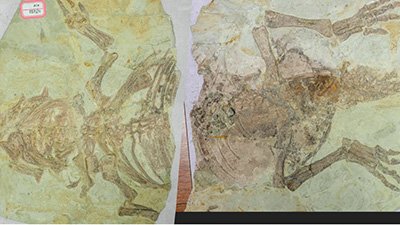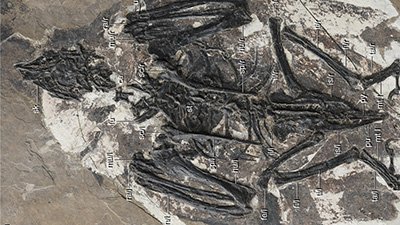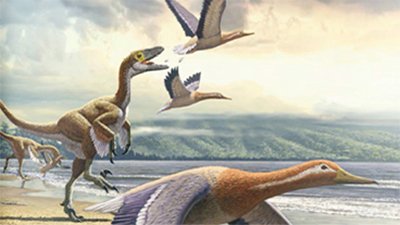
Feathered Dinosaurs?
Dinosaurs to Birds?
The fossil record does not reveal an evolutionary progression in feather development, nor does it reveal transitional animals that are part bird and part dinosaur. No scientific observations have ever shown a way that dinosaurs could acquire the genetic information to make the dramatic changes that would have been necessary to evolve into birds.
Microraptor
Since no definitive dinosaurs with feathers have appeared in the fossil record—only dinosaurs with fuzzy-looking collagen fibers that do not qualify in any way as transitional feathers—many evolutionists seeking to explain the evolution of feathers would like to find transitional evolutionary forms. Microraptor did not help their case.
Feathered Dinosaurs
Nothing in the Bible precludes the erstwhile existence of feathered dinosaurs. What the Bible does indicate is that if feathered dinosaurs were to have existed, they would have been created with feathers; they did not evolve from reptilian scales, which are quite different.
News About Feathered Dinosaurs?
-
Nov. 25, 2024 from Ken Ham Blog
A recent article shares about one specific, very well-preserved bird fossil that challenges evolutionary assumptions about dinosaur-to-bird evolution.
-
May 29, 2024 from Ken Ham Blog
Has a new study on Psittacosaurus really proven that so-called feathered dinosaurs had both reptile and birdlike skin?
-
Nov. 2, 2023 from Ken Ham Blog
What should we make of a headline like this: “Dinosaur feathers may have been more birdlike than previously thought”?
-
May 4, 2023 from Ken Ham Blog
In a chunk of amber, researchers discovered bits of downy feathers and larval molts from beetles that are very similar to beetles that live today.
Articles About Feathered Dinosaurs?
-
April 29, 2023 from Answers in Depth
Cratonavis zhui is an alleged link between dinosaurs and birds.
-
Nov. 22, 2022 from News to Know
Are you thankful for your dinosaur’s drumsticks?
-
Nov. 1, 2018 from Answers Magazine
Evolution is so ingrained in our culture that most people assume modern-looking birds didn’t live with dinosaurs, but this is not the case.
-
Sept. 7, 2018 from Answers in Depth
Did dinosaurs evolve into birds? Are the birds we see at our window actually feathered dinosaurs? For many evolutionists these claims are unassailable facts.
-
March 2, 2018 from The New Answers Book 1
What does the Bible tell us about the origin of birds, and just how good is the scientific evidence that some dinosaurs evolved into birds?
-
Dec. 12, 2016 from Answers in Depth
Once again the popular media is abuzz with a new evolutionary breakthrough. This time it is purported to be a feathered dinosaur tail trapped in amber!
-
In-Depth ArticleCan Scientists Rewind Supposed Evolution of Dinosaurs to Birds?April 28, 2016 from Answers in Depth
Evolutionary scientists think birds evolved from dinosaurs and to help prove it, they’ve engineered a chicken embryo to grow a dinosaur-like lower leg.
-
In-Depth Article“Ostrich-Mimic” Is an Un-Feathered DinosaurNov. 12, 2015 from Answers in Depth
Despite claims they had prehistoric plumage, Ornithomimus fossils are devoid of feathers.
-
Sept. 24, 2015 from Countering the Culture
Zhenyuanlong is not a blow to biblical belief or proof that dinosaurs evolved into birds, but a testimony to avian diversity of the pre-Flood world.
-
In-Depth ArticleDid All Dinosaurs Have Feathers?Aug. 2, 2014 from Answers in Depth
Get used to seeing feathers on all evolutionary depictions of dinosaurs, not just theropods!
-
Do Four-Winged Birds Confirm Dinosaur Role in Flight Evolution?March 30, 2013 from News to Know
Do four-winged Cretaceous birds confirm dinosaurs’ role in the evolution of flight?
-
How Can We Say a Feathery Dinosaur is a Bird?Feb. 9, 2013 from News to Know
Since last week’s discussion of the feathered fossil Eosinopteryx, we have received questions about how we could consider this animal a bird.
-
Was Tiny Feathered Creature Dinosaur or Bird?Feb. 2, 2013 from News to Know
It’s an itsy-bitsy . . . dinosaur? Or bird?
-
Feathered Dinosaurs Found in Canada?Nov. 17, 2012 from News to Know
Were feathered dinosaurs found in Canada?
-
Blogger: Evolutionists who Reject Feathered Dinosaurs “Misguided”Sept. 22, 2012 from News to Know
Popular paleo-blogger calls evolutionists who reject feathered dinosaurs “misguided.”
-
Fine Filaments for Feathered DinosaursJuly 28, 2012 from News to Know
Fine filaments on Bavarian theropod boasted to “bridge the considerable gap” between “feathered dinosaur” groups.
-
Gigantic Dinosaur Reportedly Has Fossilized FeathersApril 14, 2012 from News to Know
Gigantic dinosaur reportedly has fossilized feathers, but don’t look too closely.
-
New Evidence Finds Dinosaurs Ate BirdsDec. 3, 2011 from News to Know
Last meal is a testament . . . but to what?
-
Oviraptor Flirting Techniques Revealed In StudyNov. 12, 2011 from News to Know
From egg-thief to devoted mother to fan-dancer, Oviraptor reputation soars in Vegas.
-
Canadian Amber Holds Fuzzy FossilsSept. 24, 2011 from News to Know
Canadian amber preserves some itsy-bitsy fuzzy fossils.
-
Dinosaur-Bird ConfusionJuly 30, 2011
Xiaotingia zhengi—the latest so-called feathered fossil in Liaoning—is providing a creative way to draft the Archaeopteryx into the dinosaur family.
-
Flap-Running Considered the Link Between Dinosaurs and FlightJuly 2, 2011
Why fly when you can flap-run up the evolutionary tree?
-
A Bird in HandFeb. 19, 2011 from News to Know
The focus of the article is purportedly “the final nail in the coffin” for those that don’t believe that birds evolved from dinosaurs. Or is this evolutionary dogma that just won’t fly away?
-
Feedback ArticleJurassic Spark?Dec. 17, 2010 from Feedback
Do chickens really take on “dinosaurian traits” inside the egg as one paleontologist claims? There’s more fluff to this claim than fact.
-
Rejection of Dinosaur-to-Bird Evolution TaleFeb. 13, 2010
“[M]ore evidence that birds did not descend from ground-dwelling theropod dinosaurs”: research from Oregon State University, home to evolutionists who reject the dinosaur-to-bird evolution tale.
-
Fossilized Melanosomes FoundJan. 30, 2010 from News to Know
Paleontologists have recovered fossilized melanosomes (which are responsible for pigmentation in skin, fur, and feathers) from ancient birds and dinosaurs.
-
Did Birds Evolve from Dinosaurs?Jan. 23, 2010 from News to Know
If alligator lungs are like bird lungs, and dinosaur lungs were like alligator lungs, does that mean birds evolved from dinosaurs?
-
Feedback ArticleDinosaur ConfusionOct. 16, 2009 from Feedback
Dinosaurs, which were really just birds, were killed off by a flood, but not Noah’s Flood? Tim Chaffey and David Wright, AiG–US, clear up some confusion about dinosaurs.
-
Final “Proof” for Fuzzy DinosOct. 3, 2009 from News to Know
It’s the “final proof” that dinosaurs evolved into birds, say scientists.
-
The Secret of the Mongolian PterosaurAug. 8, 2009 from News to Know
What were pterosaurs really like? An uncertain topic grows all the more perplexing after a new look at an old fossil.
-
Another Evolutionary FlapJune 20, 2009 from News to Know
Last week we reported on a solid scientific study that dismissed dinosaur-to-bird evolution. Of course, some researchers have yet to catch on.
-
Birds Are Not Dinosaurs!June 13, 2009 from News to Know
The allegation that birds evolved from dinosaurs is frequently treated as factual by evolutionists. But an unexpected discovery about bird anatomy refutes this.
-
Birds Did Not Evolve from Dinosaurs, Say EvolutionistsJune 12, 2009
Oregon State University scientists have released a new study debunking the alleged evolution of dinosaurs into birds.
-
Fluffy DinosMarch 21, 2009 from News to Know
A fossilized feathered dinosaur found in China—are they serious this time?
-
New Argentinian Dinosaur Fossil May Hold Dino-Bird ConnectionOct. 4, 2008
A dinosaur unearthed in Argentina could be the latest evidence for a dino–bird connection, paleontologists report.
-
Magazine Department ArticleThe Early Bird Catches the DinosaurSept. 1, 2008 from Answers Magazine
Bird fossils are found with dinosaur fossils.
-
Bird Fossil Found, Dating Back to the Dinosaur EraMay 10, 2008
Dubbed “the dawn of the Confucius bird,” a new bird fossil discovered in China is said to be from the time of the dinosaurs but is remarkably well preserved.
-
Magazine Department ArticleBirds Under FireOct. 1, 2007 from Answers Magazine
The claim that birds evolved from dinosaurs is widely accepted by secular scientists and in popular culture.
-
Magazine Department ArticleChick-osaur?Oct. 1, 2007 from Answers Magazine
The Bible clearly states that birds were created before the dinosaurs.
-
Feathered Raptors: Not the BirdsSept. 29, 2007
Bumps on the forearm bone of a velociraptor fossil are creating considerable excitement for advocates of the dinosaurs-to-birds hypothesis.
-
Tiny Mongolian Dinosaur Wreaks HavocSept. 15, 2007
A tiny Mongolian dinosaur is wreaking havoc on evolutionists’ traditional ideas of how flight (and birds) evolved.
-
Dinosaurs Contrasted with Birds: Breeding AgeJuly 28, 2007
Dinosaur youths may have mated before physically mature, according to some scientists.
-
Another feathered dinosaur?June 15, 2007
Are the media’s renderings of Gigantoraptor as a proto-bird the product of evidence—or of gigantic imagination?
-
Birdy-o-saur Under DisputeMay 26, 2007
A key fossil said to uphold that dino-to-bird link is under attack.
-
But Will It Fly?April 26, 2001
The New York Times has summarized an upcoming article in the journal 'Nature' that claims that a fossil dinosaur—supposedly with 'clear traces of feathers from head to tail'—has been found in China.
-
Archaeoraptor Hoax Update—National Geographic Recants!March 2, 2000
As more evidence of altered fossils begins to surface, one must seriously question the integrity of the fossil industry and the stories these fossils are supposed to tell.
-
“. . . Sensationalistic, Unsubstantiated, Tabloid Journalism.”Nov. 1, 1999
A letter from Storrs L. Olson to Dr. Peter Raven about dinosaur to bird evolution.
Recommended Resources

Answers in Genesis is an apologetics ministry, dedicated to helping Christians defend their faith and proclaim the good news of Jesus Christ.
- Customer Service 800.778.3390
- Available Monday–Friday | 9 AM–5 PM ET
- © 2026 Answers in Genesis










